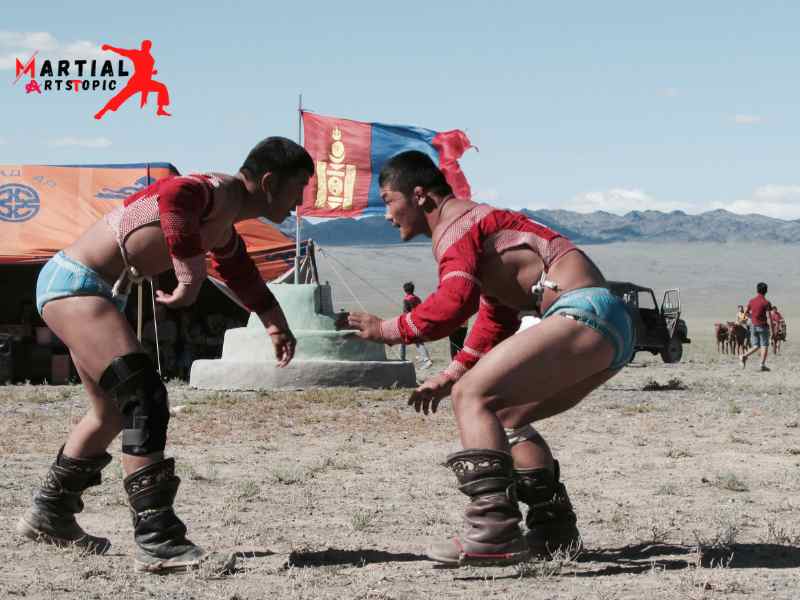
Catch Wrestling: Submission Hold and Pain Compliance Techniques
Catch Wrestling, renowned for its emphasis on technical excellence and adaptability, boasts an arsenal of submission holds and pain compliance techniques that set it apart in the realm of grappling arts. Rooted in the pragmatic approach of “catch as catch can,” Catch Wrestling practitioners are adept at seamlessly transitioning between various submission holds, joint locks, and strangleholds to control and dominate opponents. From the bone-crunching pressure of a double wrist lock to the intricate mechanics of a guillotine choke, Catch Wrestling submission holds are executed with precision and efficiency, exploiting opponents’ weaknesses while maximizing leverage and positioning. Furthermore, Catch Wrestling incorporates pain compliance techniques, such as nerve holds and pressure points, which can be used to induce discomfort and compliance in opponents, creating openings for further attacks or transitions. Through rigorous training and meticulous attention to detail, practitioners of Catch Wrestling hone their skills in submission holds and pain compliance techniques, mastering the art of grappling with finesse and effectiveness.
Understanding Submission Hold
- The essence of submission holds lies in controlling and immobilizing opponents through joint locks or chokeholds.
- Key principles include leverage, pressure, and timing, enabling practitioners to subdue adversaries regardless of size or strength.
- Common submission holds include arm bars, leg locks, rear naked chokes, and guillotine chokes, each designed to exploit vulnerabilities and induce submission.
Mastery of Pain Compliance Techniques
- Pain compliance techniques leverage discomfort to compel opponents into compliance or submission.
- Techniques such as wrist locks, neck cranks, and pressure points exploit the body’s anatomical weaknesses, inflicting pain to gain control.
- Pain compliance serves as both a deterrent and a means of controlling resistant opponents, requiring precise application and an understanding of human physiology.
The Art of Transitioning
- Catch Wrestling emphasizes fluid transitions between submission holds and pain compliance techniques.
- Practitioners must anticipate opponents’ reactions and adapt their tactics accordingly, seamlessly transitioning from one technique to another to maintain dominance.
- Mastery of transitions requires a deep understanding of grappling mechanics and relentless drilling to develop muscle memory and reflexes.
Practical Application in Combat and Competition
- Catch Wrestling’s submission holds and pain compliance techniques find application in various contexts, from competitive grappling tournaments to real-world self-defense scenarios.
- In mixed martial arts (MMA), Catch Wrestling techniques complement striking and wrestling skills, offering fighters a versatile arsenal for both offense and defense.
- The effectiveness of Catch Wrestling lies in its adaptability and versatility, allowing practitioners to dictate the pace and outcome of a grappling exchange.
Training and Development
- Training in Catch Wrestling involves rigorous drilling, sparring, and live grappling sessions to hone technical proficiency and conditioning.
- Emphasis is placed on functional strength, flexibility, and cardiovascular endurance, essential for executing techniques with precision and power.
- Experienced coaches and training partners play a crucial role in the development of Catch Wrestling practitioners, providing guidance, feedback, and opportunities for growth.
What is Catch Wrestling?
What is Catch Wrestling? Catch Wrestling, often hailed as the “sport of kings” within the realm of grappling arts, is a dynamic and pragmatic form of wrestling renowned for its emphasis on technical proficiency and adaptability. Originating from the carnival circuits and athletic exhibitions of 19th-century Europe, Catch Wrestling distinguishes itself by its no-nonsense approach to combat, where practitioners are encouraged to seize any opportunity to gain advantage over their opponents. Unlike traditional wrestling styles, Catch Wrestling encompasses a wide array of techniques, including takedowns, submissions, pins, and pain compliance holds, allowing for a versatile and comprehensive grappling repertoire. With its roots deeply embedded in practicality and real-world effectiveness, Catch Wrestling continues to captivate practitioners and enthusiasts worldwide, offering a rich tapestry of history, tradition, and martial prowess.
Origins of Catch Wrestling:
Catch Wrestling traces its origins to the bustling carnivals and fairs of 19th-century Europe, where it emerged as entertainment and spectacle. Wrestlers would engage in no-holds-barred contests, using a blend of grappling techniques to outmaneuver and subdue opponents. The term “Catch” itself reflects the ethos of seizing opportunities and improvising in the heat of battle, making use of any hold or maneuver available to secure victory.
History and Origins
The roots of Catch Wrestling can be traced back to various grappling traditions, including Lancashire Catch-as-Catch-Can wrestling in England and various folk wrestling styles across Europe. These regional influences contributed to the development of Catch Wrestling’s unique blend of techniques, characterized by its emphasis on joint locks, submissions, and pins. Over time, Catch Wrestling gained popularity and spread to other parts of the world, developing into a respected combat sport with its own set of rules and conventions.
Evolution of Catch Wrestling

Throughout its history, Catch Wrestling has undergone periods of evolution and refinement, adapting to changes in societal norms, technological advancements, and the emergence of new combat sports. In the late 19th and early 20th centuries, Catch Wrestling reached its zenith of popularity, with legendary figures such as Karl Gotch and Frank Gotch dominating the competitive circuit. However, the rise of professional wrestling and other combat sports led to a decline in Catch Wrestling’s prominence in the mid-20th century.
Despite these challenges, Catch Wrestling has experienced a resurgence in recent years, fueled by a growing interest in traditional martial arts and the practical effectiveness of its techniques. Organizations such as the International Catch Wrestling Alliance (ICWA) and Catch Wrestling United (CWU) have emerged to promote and preserve the art of Catch Wrestling, hosting tournaments, seminars, and training camps around the world.
Fundamentals of Catch Wrestling
At the core of Catch Wrestling lie the fundamental principles that define its essence as a grappling art. These fundamentals encompass a range of techniques and strategies designed to control and dominate opponents while maintaining positional advantage. Key elements include mastering takedowns to initiate grappling exchanges, utilizing superior leverage and body positioning to secure advantageous holds, and seamlessly transitioning between positions to maintain control and pressure. Moreover, Catch Wrestling emphasizes the importance of adaptability and creativity, encouraging practitioners to improvise and capitalize on openings as they arise. By honing these fundamental skills through dedicated training and practice, Catch Wrestling practitioners develop a solid foundation upon which to build their grappling prowess, enabling them to excel in both competitive settings and real-world self-defense scenarios.
Joint Locks
Joint locks are a cornerstone of Catch Wrestling, allowing practitioners to manipulate an opponent’s joints, typically the elbow, shoulder, wrist, or knee, to gain control or force a submission. Common joint locks in Catch Wrestling include:
- Straight Arm Lock: In this technique, the wrestler applies pressure to the opponent’s elbow joint, hyper-extending the arm to induce pain and submission.
- Kimura Lock: Also known as the double wristlock, the Kimura Lock targets the shoulder joint by locking the opponent’s arm behind their back, applying torque to force a tap-out.
- Toe Hold: This submission targets the ankle joint, with the wrestler controlling the opponent’s foot and applying pressure to bend the foot in an unnatural direction.
Proper execution of joint locks in Catch Wrestling involves precise positioning, leverage, and timing. Practitioners must learn to recognize opportunities to apply these techniques during grappling exchanges, often transitioning seamlessly from control positions to submission attempts.
Pins and Control Positions
Pinning techniques are integral to Catch Wrestling, allowing wrestlers to immobilize their opponents and secure victory. Control positions serve as the foundation for effective pinning, enabling the wrestler to dominate the opponent while minimizing their ability to escape. Common pins and control positions in Catch Wrestling include:
- Side Control: The wrestler secures a dominant position by pinning the opponent’s back to the mat while controlling their hips and shoulders.
- Mount: In this position, the wrestler straddles the opponent, sitting on their chest or abdomen, effectively immobilizing them while maintaining control.
- Half Nelson: The wrestler applies pressure to the opponent’s head and shoulder, leveraging their weight to restrict movement and facilitate a pin.
Mastering pins and control positions requires a combination of leverage, weight distribution, and awareness of the opponent’s reactions. Wrestlers must be adept at maintaining control while anticipating and countering escape attempts.
Striking and Submissions

While Catch Wrestling primarily focuses on grappling techniques, strikes can also play a role in certain situations, particularly in self-defense scenarios or mixed martial arts competition. Open-handed strikes, forearms, and elbows are commonly utilized to create openings, disrupt the opponent’s balance, or soften them up for submission attempts.
Besides joint locks, Catch Wrestling practitioners are proficient in various submission holds designed to force an opponent to concede defeat. These submissions can target different areas of the body, including the neck, spine, and limbs, and may involve chokes, compression locks, or cranks.
Overall, the fundamentals of Catch Wrestling encompass a diverse array of techniques, emphasizing both control and submission. By mastering the principles of joint locks, pins and control positions, and striking and submissions, practitioners can develop a well-rounded skill set that is effective in both competitive grappling and real-world confrontations.
Training methods
Training methods in Catch Wrestling are designed to develop technical proficiency, physical conditioning, and mental toughness essential for success in grappling. Practitioners engage in a variety of training modalities, including drilling sequences, live sparring, and conditioning exercises. Drilling sequences involve repeated practice of specific techniques and transitions to build muscle memory and refine execution. Live sparring sessions allow practitioners to apply learned techniques in dynamic, real-world scenarios against resisting opponents. Conditioning exercises focus on improving strength, endurance, and agility through activities such as weight training, cardiovascular workouts, and bodyweight exercises. Additionally, mental training techniques, such as visualization and mental rehearsal, are employed to enhance focus, concentration, and resilience. By incorporating these diverse training methods into their regimen, Catch Wrestling practitioners develop a well-rounded skill set and prepare themselves for the physical and mental challenges of competition and self-defense.
Drilling Sequences
Drilling sequences are a cornerstone of Catch Wrestling training, allowing practitioners to refine their techniques and develop muscle memory through repetitive practice. During drilling sessions, practitioners work through specific grappling sequences, focusing on fundamental movements, transitions, and submissions. These drills are often performed in a controlled environment, allowing practitioners to concentrate on technique without the pressure of live sparring. By breaking down complex movements into manageable segments and repeating them consistently, practitioners can internalize the mechanics of Catch Wrestling and improve their execution in real-world scenarios.
Sparring and Live Grappling
Sparring and live grappling are integral components of Catch Wrestling training, providing practitioners with the opportunity to test their skills against resistant opponents in a simulated combat environment. Unlike drilling sequences, sparring sessions are dynamic and unpredictable, requiring practitioners to adapt to their opponent’s movements and react in real-time. During sparring sessions, practitioners focus on applying techniques learned during drilling, as well as developing strategic awareness, timing, and positional control. Through regular sparring, practitioners gain valuable experience, refine their instincts, and learn to effectively apply Catch Wrestling techniques under pressure.
Advanced Techniques for Catch Wrestling
Catch Wrestling, renowned for its emphasis on control, submission holds, and strategic positioning, offers a vast array of techniques for practitioners to master. While the fundamentals form the cornerstone of this grappling art, advancing to higher levels entails delving into more intricate maneuvers and refining existing skills.
Counters and Reversals
A hallmark of Catch Wrestling is its adaptability and responsiveness to an opponent’s movements. Advanced practitioners excel in the art of countering and reversing their opponent’s attacks, turning defensive situations into offensive opportunities. Common counters and reversals include:
- Granby Roll: A versatile defensive maneuver used to escape from bottom positions, the Granby Roll involves rolling through and away from an opponent’s control, creating space to initiate a counterattack or regain a dominant position.
- Whizzer Counter: When an opponent attempts a takedown, the Whizzer Counter involves sprawling and applying pressure with the whizzer (overhook), thwarting the takedown attempt and potentially transitioning into a submission or reversal.
- Kimura Counter to Armbar: Against an opponent’s Kimura Lock attempt, the skilled Catch Wrestler can counter by transitioning into an armbar, leveraging their positioning and momentum to secure a submission victory.
Mastering counters and reversals requires anticipation, timing, and awareness of the opponent’s movements. Advanced practitioners possess a keen understanding of leverage and positioning, enabling them to effectively neutralize their opponent’s attacks and gain the upper hand.
Transitional Grappling
Transitional grappling refers to the seamless flow of techniques and movements between different positions and submissions. Advanced Catch Wrestlers excel in transitioning fluidly from one technique to another, capitalizing on openings and maintaining control throughout the exchange. Key aspects of transitional grappling include:
- Positional Awareness: Advanced practitioners possess a deep understanding of positional hierarchies and transitions, allowing them to anticipate their opponent’s movements and preemptively adjust their positioning to maintain control or secure a submission.
- Chain Wrestling: Chain wrestling involves stringing together a series of techniques and movements in rapid succession, creating continuous pressure and forcing the opponent to react defensively. Advanced Catch Wrestlers employ chain wrestling to overwhelm their opponents and dictate the pace of the match.
- Submission Chains: Rather than relying on isolated submission attempts, advanced practitioners utilize submission chains—sequences of submissions and transitions—to systematically break down their opponent’s defenses and secure a submission victory.
Developing proficiency in transitional grappling requires hours of dedicated practice and a willingness to experiment with different techniques and combinations. Advanced practitioners continually refine their transitions, honing their ability to seamlessly flow from one position to the next.
Escapes and Defenses
While Catch Wrestling emphasizes offensive techniques, proficiency in escapes and defenses is equally essential for advanced practitioners. Effective escapes and defenses enable wrestlers to nullify their opponent’s attacks and regain control of the match. Key aspects of escapes and defenses include:
- Technical Stand-Up: When trapped on the bottom, the technical stand-up allows the wrestler to rise to their feet while maintaining a defensive posture, minimizing the risk of exposing themselves to further attacks.
- Guard Recovery: Advanced practitioners excel in recovering guard—a defensive position where the wrestler uses their legs to control and neutralize their opponent—after being taken down or swept, preventing their opponent from advancing to a dominant position.
- Submission Defense: Advanced Catch Wrestlers possess a comprehensive arsenal of submission defenses, including hand fighting, positioning adjustments, and strategic escapes, enabling them to withstand their opponent’s submission attempts and turn the tide of the match.
Mastery of escapes and defenses requires a combination of technical proficiency, situational awareness, and mental resilience. Advanced practitioners prioritize defense as a means of minimizing risk and creating opportunities to launch their own attacks.
Training Tips and Competing in Catch Wrestling: A Comprehensive Guide
Training and competing in Catch Wrestling require a multifaceted approach that encompasses technical proficiency, physical conditioning, and mental resilience. To excel in Catch Wrestling, practitioners should prioritize consistent drilling of techniques, focusing on mastering fundamental movements and transitions. Engaging in live sparring sessions is essential for applying learned techniques in dynamic, real-world scenarios against resisting opponents. Additionally, practitioners should focus on conditioning exercises to improve strength, endurance, and flexibility, ensuring they are physically prepared for the demands of competition. Mental preparation is equally important, with practitioners encouraged to visualize success, manage pre-match nerves, and stay focused during competition. When competing in Catch Wrestling tournaments, it’s essential to study opponents, develop a strategic game plan, and adapt tactics based on the flow of the match. Lastly, practitioners should approach both training and competition with dedication, perseverance, and a growth mindset, continuously striving for improvement and learning from every experience. By incorporating these training tips and competition strategies into their regimen, practitioners can maximize their potential and achieve success in the world of Catch Wrestling.
Training Tips
- Master the Fundamentals: Focus on mastering the fundamental techniques of Catch Wrestling, such as takedowns, submissions, and positional control. A solid foundation is essential for building advanced skills and strategies.
- Consistent Drilling: Regular drilling of techniques is crucial for developing muscle memory and proficiency. Set aside dedicated time for drilling sequences and repetitions to reinforce proper form and technique.
- Embrace Live Sparring: Engage in live sparring sessions to apply techniques in realistic grappling scenarios. Sparring allows you to test your skills against resisting opponents and adapt to different grappling styles.
- Cross-Train: Supplement your Catch Wrestling training with other grappling arts, such as Brazilian Jiu-Jitsu or Judo, to expand your skill set and gain insights into different grappling strategies.
- Focus on Conditioning: Develop physical conditioning through strength training, cardiovascular exercises, and flexibility drills. Conditioning improves endurance, agility, and resilience during intense grappling matches.
Competing in Catch Wrestling
- Mental Preparation: Prepare mentally for competition by visualizing success, staying focused, and managing pre-match nerves. Confidence in your abilities and mental toughness are key factors in performing well under pressure.
- Study Your Opponents: Research your opponents’ strengths, weaknesses, and tendencies to develop a strategic game plan. Adapt your approach based on your opponent’s style and preferences.
- Play to Your Strengths: Capitalize on your strengths and preferred techniques during competition. Focus on executing your game plan effectively and imposing your will on your opponent.
- Stay Calm and Composed: Maintain composure during matches, even in challenging situations. Stay patient, be mindful of your breathing, and remain focused on executing your techniques with precision.
- Learn from Every Experience: Win or lose, each competition provides valuable learning opportunities. Analyze your performance, identify areas for improvement, and adjust your training regimen accordingly to continue progressing as a grappler.
The Benefits and Considerations of Catch Wrestling

Catch Wrestling offers a plethora of benefits to practitioners, ranging from physical conditioning and self-defense skills to mental fortitude and camaraderie. Practicing Catch Wrestling promotes overall fitness by improving strength, flexibility, and cardiovascular endurance through dynamic grappling movements and conditioning exercises. Additionally, the practical self-defense techniques taught in Catch Wrestling provide practitioners with invaluable skills for real-world situations, empowering them to defend themselves effectively. Furthermore, engaging in Catch Wrestling fosters mental toughness and resilience, as practitioners learn to overcome challenges, adapt to adversity, and stay focused under pressure. However, practitioners should also consider the potential risks and considerations associated with Catch Wrestling, such as the risk of injury during training and competition, the steep learning curve for mastering techniques, and the importance of training under qualified instructors to ensure safety and proper technique. By weighing these factors and approaching training with caution and respect, practitioners can reap the many benefits of Catch Wrestling while mitigating potential risks.
Benefits of Catch Wrestling
- Comprehensive Grappling Skills:
Catch Wrestling provides practitioners with a comprehensive set of grappling skills, including takedowns, submissions, pins, and escapes. By mastering a diverse array of techniques, practitioners develop a well-rounded skill set that can be applied in various grappling scenarios, both in sport and self-defense. - Practical Self-Defense:
The techniques taught in Catch Wrestling are highly practical for self-defense situations. Unlike some traditional martial arts, Catch Wrestling emphasizes real-world effectiveness, focusing on controlling opponents and neutralizing threats efficiently and decisively. - Physical Conditioning:
Training in Catch Wrestling promotes physical conditioning, improving strength, endurance, flexibility, and cardiovascular fitness. The dynamic nature of grappling requires practitioners to engage multiple muscle groups simultaneously, resulting in a comprehensive full-body workout. - Mental Toughness:
Catch Wrestling challenges practitioners both physically and mentally, fostering mental toughness, resilience, and problem-solving skills. Competing in Catch Wrestling tournaments requires practitioners to stay focused, adapt to changing situations, and maintain composure under pressure. - Camaraderie and Community:
Practicing Catch Wrestling fosters a sense of camaraderie and community among practitioners. Whether training partners or fellow competitors, Catch Wrestlers often form strong bonds through shared experiences, mutual respect, and a passion for the art.
Considerations of Catch Wrestling:
- Risk of Injury:
As with any contact sport, there is a risk of injury associated with practicing Catch Wrestling. Techniques such as joint locks and submissions can cause strain or injury if applied incorrectly or resisted forcefully. Practitioners should prioritize safety and proper technique to minimize the risk of injury during training and competition. - Learning Curve:
Catch Wrestling has a steep learning curve, particularly for beginners. Mastering the nuances of grappling, including leverage, timing, and positioning, requires dedication, patience, and consistent practice. Beginners may feel overwhelmed by the complexity of techniques and concepts initially but can gradually progress with guidance and persistence. - Rule Set Variations:
Catch Wrestling tournaments may have different rule sets and regulations depending on the organizing body or event. Practitioners should familiarize themselves with the specific rules and guidelines governing competitions they intend to participate in to ensure compliance and avoid penalties or disqualification. - Limited Availability:
Unlike more mainstream martial arts, such as Brazilian Jiu-Jitsu or Judo, Catch Wrestling may have limited availability in terms of training facilities and qualified instructors. Practitioners may need to seek out specialized Catch Wrestling gyms or supplement their training with online resources and seminars.
Conclusion
What is Catch Wrestling? Catch Wrestling stands as a dynamic and formidable grappling art with a rich history and enduring legacy. Originating from the carnival circuits of 19th-century Europe, Catch Wrestling has developed into a respected combat sport known for its technical proficiency, practicality, and emphasis on real-world effectiveness.
At its core, Catch Wrestling embodies the ethos of seizing opportunities and improvising in the heat of battle, making use of any hold or maneuver available to secure victory. Its comprehensive grappling skills, including takedowns, submissions, pins, and escapes, provide practitioners with a versatile arsenal for both sport and self-defense.
Practicing Catch Wrestling offers a host of benefits, including physical conditioning, mental toughness, camaraderie, and practical self-defense skills. However, it is not without its considerations, such as the risk of injury, learning curve, rule set variations, and limited availability.
What is Catch Wrestling? Catch Wrestling is more than just a martial art—it is a journey of self-discovery, discipline, and personal growth. By approaching training and competition with dedication, respect, and caution, practitioners can unlock the full potential of Catch Wrestling and experience the thrill of mastering one of the most dynamic grappling arts in the world.
